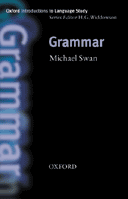
June 2006
Volume 10, Number 1
| Contents | | | TESL-EJ Top |
 |
June 2006
|
||
|
Grammar | |||
| Author: | Michael Swan (2005) |  | |
| Series: |
Oxford Introductions to Language Study, Series Editor: H.G. Widdowson | ||
| Publisher: | Oxford: Oxford University Press | ||
| Pages | ISBN | Price | |
|---|---|---|---|
| Pp. xiv + 129 | 978-0-19-437241-1 (0-19-437241-3) | £ 9.25 (hardback) | |
Grammar delivers a clear and concise account of grammar and its key concepts. It provides a large-scale overview of various areas of language study and as such "it can serve as preliminary to (and precondition for) [a] more specific and specialized enquiry" (p. x). More detailed features of key concepts are left to books at other levels of grammar analysis. In line with the series design, the author's main concern is with drawing a broad map of the subject at stake rather than offering a close scrutiny, which "can be myopic and meaningless unless it is related to the larger view" (p. ix). The book is meant to be an introductory text for a twofold target audience comprising both students new to linguistics and lay people who might be interested in language without being academically engaged in language study per se.
The book intends to show that grammar is not necessarily dull and problematic. Quite the contrary (according to Swan), grammar is fascinating because it is not arbitrary at all - as normally believed - and it is not a series of prescriptive rules but an understandable topic, where everything has a function, relates to something else and can be explained. Whatever might appear to be complicated and bewildering finds its explanation in a patchwork of factors ranging from time to language use and users.
Swan asks his readers to relinquish the belief that grammar is simply a matter of word and/or sentence building. He ponders what exists beyond the word and insists on the formally different means we - as speakers of different languages - resort to when we express different meanings. A wide range of examples taken from a wide range of the world's languages supports the description of grammar mechanisms: for instance, "the notion expressed by English prepositions may be conveyed elsewhere by using verbs (as when we say in English 'facing' to mean 'opposite')", the practice in Finnish of using noun endings to express many spatio-temporal relationships, or the South American language Quechua having affixes where English has personal pronouns (p. 21).
Similarities and differences among languages are highlighted throughout the book, and some intriguing topics for both audiences are introduced, one such being the mismatch between word classes in different languages. The Nivkh language, spoken at the far eastern edge of the Asian continent, has over 60 classifiers, while Mandarin Chinese's choice of classifiers depends on the subclass of the following noun. Other variations pointed out among the grammar of languages include the number of genders extending to as many as twenty, and what is feminine in one language being masculine in another; language relativity (do speakers perceive, categorize and encode reality differently from one language to another?); and different types of structures. Additionally, passing reference is made to the very elaborate grammatical devices for showing respect and relative social status in Far Eastern languages such as Korean or Javanese, in contrast to the "closer" languages' (e.g., English) way of dealing with the parameters of distance and proximity in social relations (p. 29). References to the degree of grammatical elaboration possible in language are several and, although stimulating, they are sometimes expressed in specialised terms, rendering some sections of the book possibly daunting for non-expert readers. However, the Glossary at the back of the book clarifies the meaning of such technical words.
The book is divided into four sections. The first one, Survey, comprises eight chapters arranged as follows:
This arrangement and the focus of the chapters allow the author to move from micro- to macro-concepts within linguistics. Language is initially presented and described as a system with its own meaningful rules. The author then shifts to a wider perspective, one which considers what lies beyond the grammar of words. He devotes his attention to language in use and to its pragmatic function, stresses the communicative and stylistic differences between spoken and written language, deals with language change at different levels - both diachronic and synchronic - and ends with a survey of generative linguistics and psycholinguistics.
In the Readings section that follows, the reader is presented with brief excerpts from specialist literature. The main purpose of this section is "to get readers to focus on the specifics of what is said, and how it is said, in these source texts" (p. xi) and "to give the reader an initial familiarity with the more specialist idiom of the linguistics literature" (p. xi). Swan prompts the reader with questions to further this purpose and to stimulate readers into a more critical approach to specific points in linguistics. This section expands upon all the topics the author introduces in the Survey section.
The contents of Grammar are clearly and fairly presented in spite of some very technical vocabulary. Such precise terminology contributes to the conciseness the series editor probably required for such compact introductions to language study. The book's structure is logical and allows the reader to easily follow the evolution of grammar within language. Swan's comments upon and references to the literature on grammar should prove helpful for teachers and students of language concepts.
Elisa Perego
University of Pavia, Italy
<elisa.perego unipv.it>
unipv.it>
|
© Copyright rests with authors. Please cite TESL-EJ appropriately.
Editor's Note: The HTML version contains no page numbers. Please use the PDF version of this article for citations. |